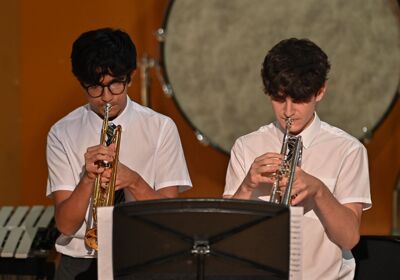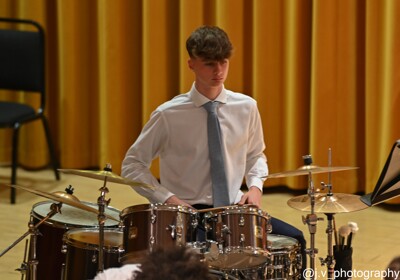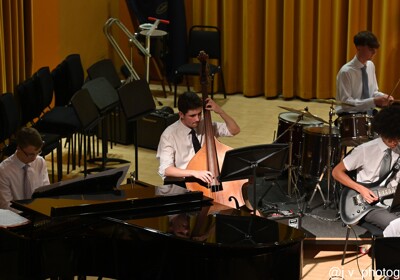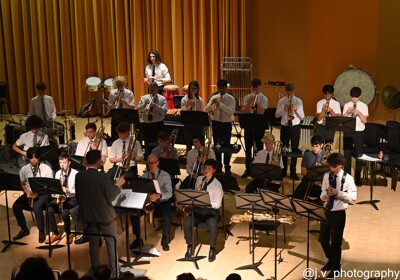Music
The Music Department is headed by Director of Music, Francis Mullaly. The department is situated in the Clarendon Muse, our specialist and award-winning music centre, consisting of several classrooms, 24 sound-proofed practice rooms, a music technology suite and recording studio and a 200 seat auditorium.
The department consists of three classroom teachers alongside a specialist team of fourteen peripatetic tutors, who teach the full range of orchestral, vocal and popular instruments. The department is thriving with around 300 individual lessons taking place every week. Students have the chance to take music examinations, including ABRSM, Trinity and RSL.
Alongside the academic curriculum, there is a busy timetable of co-curricular music ensembles taking place before school, breaktime, lunchtime and after-school. These groups include:
-
Big Band and Trad Jazz Bands
-
Beginner, Junior and Senior Orchestra
-
Junior, Senior and Chamber Choir
-
Junior, Intermediate and Senior Wind Band
-
Brass Band and Brass Ensemble
-
Chamber ensembles (including Brass Ensemble, Fuller and Chilcott String Quartets, Pop and Rock bands, Swing Bands and A Cappella groups).
Many of our students also perform in the annual WBGS Musical, where we collaborate and welcome students from WGGS. We are fortunate to have our own 300 seat specialist performance venue (The James Theatre), a Dramatist in Residence, full cast, live pit band and technical crew. Recent highlights include Oliver!, School of Rock and an upcoming performance of The Wizard of Oz in February 2024.
There is a full concert schedule where over two hundred students perform including sold-out Autumn and Spring Showcase concerts, Founders Day and an annual Carol Service. In the Summer term, we also have an annual Music Competition judged by a visiting professional adjudicator and our musicians have a chance to perform in weekly WBGS assemblies. Finally, the WBGS Music Department collaborates with the Watford School of Music, who share the same Clarendon Muse facilities. Many of our students are involved in a full range of ensembles throughout the week, including Watford Youth Orchestra, and some musicians are further represented at both County and National levels. Indeed, GCSE and A-Level uptake greatly exceeds national levels and WBGS students achieve some of the highest results in the county. Within successive A-Level cohorts, students have gone on to study Music at top academic universities and music conservatoires, alongside a plethora of other degree courses.
Music Facilities
The Clarendon Muse offers outstanding specialist music facilities in a modern and purpose-built environment. The classrooms are equipped with keyboards and there are 43 computers which run the award-winning Sibelius Ultimate software. The 24 sound-proofed rooms provide ample opportunity for small groups to rehearse. At other times, these rooms are also available to students for private practice. The auditorium is equipped with a Steinway grand and there is a further upright Steinway in the block and a Yamaha C4 in the foyer.. The recording studio is equipped to a high standard with two Apple Mac computers linked to a recording desk to enable students to develop their skills in music production and recording.
Key Stage 3
Key Stage 3
We aim, from your very first day in the WBGS Music Department, to instil a life-long love for music-making. Through a carefully considered approach to the sequencing of skills, we want students to maximise progress as performers and composers, and thereby increase their self-confidence, creativity and sense of achievement. The music curriculum gives students ample opportunity to work with the elements of music in their composing, performing, listening and appraising. The course covers a wide variety of music drawn from many different traditions, including music by the great composers. Each unit of work allows students to perform as soloists or in a classroom ensemble and to develop their instrumental and vocal skills with an emphasis on fluency, control and expression. Students are also taught how to use music notation and how to engage appropriately with music technology to enhance their compositional skills. Over the last four years, students have been learning about some of the great compositions through the BBC Ten Pieces series. Our intent is to build on the WBGS Learner Attributes that they encounter from the start of their journey with us, encouraging students to take the initiative in performance and to collaborate with others in small group activities. We aim to encourage them to think carefully about the effect different music has on us and to build a good level of resilience, especially in performing activities. Hopefully the implementation of our music curriculum will impact on students such that they continue to have a love of music for life.
The details below give a snapshot of each of the units of work.
YEAR 7
UNIT 1 - MUSICAL ELEMENTS AND NOTATION
From the outset, a focus on singing appears throughout the curriculum, with a carefully sequenced set of warmups and pieces enabling students to develop confidence, technique and expression (regardless of prior singing experience). Students focus on understanding the full range of musical elements and applying the language in relation to pieces of music. Theoretical knowledge is developed through reading increasingly complex rhythmic notation and composing layered pieces for untuned percussion. Core terminology and notation is continually reinforced through the use of the software, Teaching Gadget, allowing students to complete low-stakes quizzing and theory games. This focus on notation is then applied to reading the treble clef and developing basic keyboard technique, allowing students to perform three mini-pieces in their final assessment by the end of term with that same focus on confidence, technical skill and musical expression.
UNIT 2 – FANFARE AND THE ORCHESTRA.
In this unit students will aim to consolidate their rhythm work from the previous unit into rhythms that might be suitable for a Fanfare. The conversion of their chosen rhythm into a melodic Fanfare enables learning and understanding of staff notation for the first time and composing a simple melody using just four pitches. Students also encounter the keyboards and the music programme Sibelius for the final write-up. The unit also allows students to begin to explore the orchestra, enhanced by the rich tapestry of orchestral pieces found in the BBC Ten Pieces repertoire. We tackle the BBC Ten Pieces 2 in the first term and then the BBC Ten Pieces 3 after Christmas.
UNIT 3 - THE ELEMENTS-COMPLETING THE PICTURE
This unit aims to consolidate on knowledge gained from the first two units and to complete their understanding of these building blocks. Students are introduced to the graphic score through the Dawn Interlude by Benjamin Britten and this in turn leads to the creation of their own composition based on the ideas portrayed in this piece.
UNIT 4 - MELODY AND DRONE
In this unit students explore drones used in different musical cultures in order to create their first composition with accompaniment. Students learn about different scales for constructing their melodies and the role of improvising in performing. Links are made with music from the Medieval and Renaissance periods. The elements are consolidated and Sibelius is used to make a fair copy of their handwritten melody and drone work.
UNIT 5 – LATIN AMERICAN DANCE MUSIC
This unit offers opportunities to improve their performing skills through learning simple chord series and continuing to develop their improvisation skills in a different musical style. The idea of a musical fusion, a key component of the KS4 course is sown here.
UNIT 6 - EOY APPRAISING AND PERFORMING
In this unit of work, students are assessed on their acquisition of knowledge across the elements and the BBC Ten Pieces. They also demonstrate their development as musicians from their initial performance in Unit 1.
YEAR 8
UNIT 7 - GROUND BASS STRUCTURES
This unit starts by focusing on the Baroque period and students are expected to prepare a presentation on the style of the music and important musicians from the early eighteenth century. The compositional and performing elements of the unit focus on developing melodic structures over a ground with links to Pachebel’s canon, whilst the listening attributes include a ground bass test on a work by Purcell. Students are able to build on all the skills developed in year 7, whilst opportunities exist for stretch and challenge for all.
UNIT 8 – THE BAROQUE CONCERTO
Following on from student presentations, this unit focuses on learning to perform a movement from the lute concerto by Vivaldi. Students can learn part of the ritornello, or indeed the whole of it whilst also attempting to improvise a simple episode using motifs taken from the ritornello. Stretch and challenge for all is the key again here, as well as giving our guitarists a chance to take up the challenge of the melody line.
UNIT 9 – MADNESS
Students continue the theme of presentations with a study of the pop group Madness, as well as learning the classic hit It must be love. The song provides the stimulus for a composition using notation software allowing for keyboard, bass, drum and melody parts to be sequenced and developed.
UNIT 10 – THE MUSICAL
This unit allows students to explore the Musical through an independent study of their favourite work. Performance elements are assessed through the study of Electricity from the musical Billy Elliott when students are challenged to prepare a performance of the song with expression and feeling.
UNIT 11 – JAPANESE MUSIC
This unit allows students to explore traditional Japanese music through music for the shakuhachi. Students are able to make comparisons between Western and Eastern musics, improvise in a different style and explore the koto and shamisen and sing the traditional song Sakura.
UNIT 12 – RONDO STRUCTURES
In this unit of study, students explore music in the Classical period through a study of Mozart. A composition and performing project on rondo consolidates reading skills, allows for developing a melody over a simple tonic-dominant chord series.
UNIT 13 – EOY APPRAISING AND PERFORMING
In this unit of work, just as in Unit 6, students are assessed on their acquisition of knowledge across the curriculum content. They also demonstrate their development as musicians in their performing assessment, which now allows for an ensemble performance, often chosen from one of the units of work in the year. It is at this point that students decide to further their studies in music leading to GCSE at the end of Year 11.
Key Stage 4
Key Stage 4
The teaching of Music at KS4 encourages students to be inspired by a variety of music from different cultures. The course aims to continue to develop skills in performing and composing learned from KS3 and generally to foster a love of making music individually and with others. It also aims to enhance broader life skills, including critical thinking, aesthetic sensitivity, emotional awareness, self-discipline, self-confidence and self-motivation. In Year 9, students study four topics, The Blues, Minimalism, Film Music and Popular Music. Within each topic, there are ample opportunities during the study of music in each of these areas to compose a piece of music, to perform as part of an ensemble and to appraise. For instance, in the unit on Film Music, students learn how to compose a scary soundtrack by combining the elements of music in a certain way, the students then perform some familiar James Bond music and then incorporate this music in a further sound track for the film Spectre.
In Year 10, students build upon the preparatory work from Year 9 across the three main disciplines of the subject, following the EDUQAS GCSE Specification. Further appraising takes through a study of musical styles and genres across the four EDUQAS Areas of Study (AoS):
-
AoS 1: Musical Forms and Devices
-
AoS 2: Music for Ensemble
-
AoS 3: Film Music
-
AoS 4: Popular Music
Performing (30%): as a soloist and as part of an ensemble for a minimum of 4 minutes. Students will receive added difficulty marks if they perform a recital of Grade 4 or higher ABRSM/Trinity/RSL standard pieces or equivalent.
Composing (30%): one free composition and one set to a brief by the Examination Board lasting at least 3 minutes in total.
Appraising (40%): A listening examination based on the detailed study of two set works and six questions of unfamiliar music.
Key Stage 5
The teaching of Music at KS5 continues to develop performance skills and compositional techniques, along with a growing understanding of harmony, aural awareness and analytical confidence over a period of two years. The lessons aim to provide the appropriate preparation for higher education courses in music whilst simultaneously hoping to continue to foster a life-long appreciation of the subject.
As with GCSE, students continue to follow the EDUQAS A-Level specification, which naturally follows on from the EDUQAS GCSE specification. A distinct plus in the EDUQAS specification allows Sixth Form students to specialise in Performance or Composition, depending on their strengths and preferences. Similarly, we expect WBGS students to be fully involved in the co-curricular life of the department, and many students at this level take real ownership for organising, leading and directing their own ensembles. Every year, students have the opportunity to feature as a soloist with the Senior Orchestra (recent highlights include Grieg’s Piano Concerto in A minor).
The requirements of the Eduqas Specification for A level are as follows:
Performing (35/25%): performing a live recital in front of a visiting examiner. Performing a minimum of two pieces, and three pieces if specialising in performance. As with GCSE, students will receive added difficulty marks if they perform a recital of Grade 7 or higher ABRSM/Trinity/RSL standard pieces or equivalent.
Composing (35/25%): composing one piece in a Western Classical style in response to one of four briefs released by EDUQAS in Year 13, and one free composition in a style of the candidate’s own choice. Students specialising in composition will compose a third piece instead of performing a third piece in their recital.
Appraising (40%): A listening examination based on the three Areas of Study:
AoS A: Development of the Symphony 1750-1900
Detailed study of two symphonies (Haydn Symphony 104 and Mendelssohn Symphony 4) alongside wider study of symphonic composers across the time period.
AoS D: Jazz 1920-1960
Wider study of six areas - Ragtime, Dixieland, Early Jazz, Big Band, Bebop and Cool Jazz. Students discuss key musical features, gain a contextual understanding and further performance experience whilst experiencing these pieces live in the classroom.
AoS E: Into the Twentieth Century
Detailed study of two pieces (Debussy’s Nuages and Poulenc’s Trio for Oboe, Bassoon and Piano) alongside the wider study of Impressionist, Neoclassical and Expressionist composers.
Exams & Assessment
GCSE
GCSE Examination Board: EDUQAS
https://www.eduqas.co.uk/qualifications/music-gcse/
A Level
A-Level Examination Board: EDUQAS
https://www.eduqas.co.uk/qualifications/music-as-a-level/
Enrichment & Extra-curricular
The Music department host a wide range of extra-curricular, bands, orchestras and choirs, the details of which can be found here:
WBGS Student Google Home Page and through Google Classroom.
Resources & Reading List
Key Stage 3
Click here for a link to the BBC Ten Pieces resource of all 40 pieces. (Year 7)
Click here for a link to Nicola Benedetti’s introduction to the Baroque period. (Year 8)
Key Stage 4
Click here for a link to piano styles in the blues. (Year 9)
Click here for the link to the GCSE Pearson Edexcel Music Specification (Year 10 and 11)
Key Stage 5
Click here for a link to the A level Pearson Edexcel Specification.
Click here for a link to the Difficulty Level Booklet for A Level.
Click here for a link to the Harmony resource for A Level.




